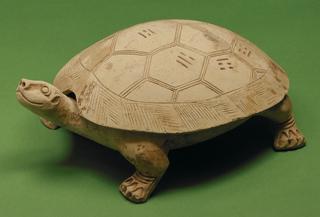
 |
Most Han pottery was made in MOLDS.
In contrast, this hand-built inkstone shows the expressiveness and wit
of a Han dynasty craftsman. Here, the artist's unique interpretation
combines ORGANIC
and GEOMETRIC
features. The head, face, feet, and shell are formed by hand to resemble
a real tortoise. Before firing, and while the clay was still damp, the
artist INCISED
patterns and symbols into the shell.
The inkstone is made of LOESS
(less), an earthen material whose low clay content prevents distortion
during drying and firing. Such pottery is usually fired at a low temperature
and left unglazed. The color is created by reducing oxygen in the kiln
during firing. The fire draws needed oxygen from the clay, replacing
the oxygen with carbon. This saturation of the clay with carbon results
in the gray tone of the inkstone.

Key ideas.
Where does it come from?
What does it look like?
How was it used?
How was it made?
How big is it?
Who Knows?
Additional resources.
